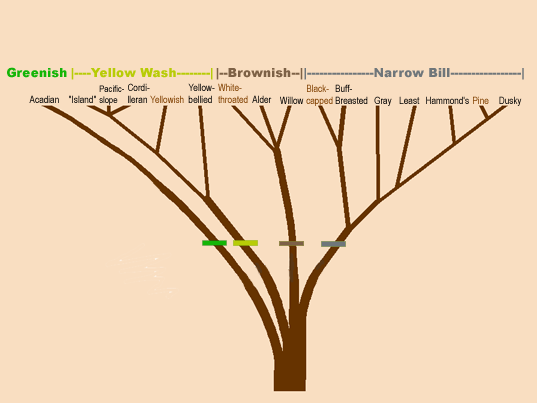
The most useful of these differences for identication is the yellowish wash on all species of Branch 2 (the second branch from the left). It has long been appreciated that this coloration separates the Yellow-bellied and the "Western Flycatcher complex" (including the Yellowish Flycatcher) from all other empids. It has now been confirmed for the first time, by Johnson and Cicero (2002), that these two lineages are each other's closest relatives. To see this, follow the Yellow-bellied Flycatcher twig down to the first node. The other branch of this node leads first to the Yellowish Flycatcher and then on to Cordilleran, Pacific-slope, and "Island" Flycatchers. The colored bar indicates the position on the tree of the hypothesized ancestor of this branch. It is likely, although not certain, that this ancestral species also had a yellowish wash.
Similarly, the colored bars and text indicate the distinctive features of appearance of the other three branches. The Acadian Flycatcher, the sole member of the first branch, is large and somewhat greener dorsally than the others. The third branch is characterized by dorsal coloration that is generally more brownish than the other branches. Branches 1, 2, and 3 all have rather broad bills. The fourth branch contains all the species with narrow and/or short bills. As a group, Branch 4 birds are also somewhat grayer, i.e., less heavily pigmented, than the other three branches. Again, these characteristics are not terribly helpful field marks for identifying isolated individuals. The point is that these are branch-specific rather than species-specific characteristics.
The color-codes on the bars and text were chosen to help you remember the distinctive coloration of the species of each branch. This coding scheme will be retained on pages to come, for any characteristic that is unique to only one branch. For characteristics shared by two or more branches, a new color will be introduced. Click here to continue the story of Empidonax evolution with a look at habitat differences.